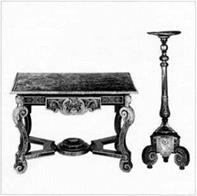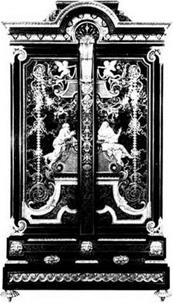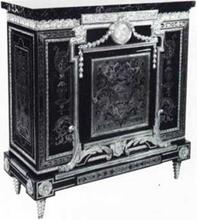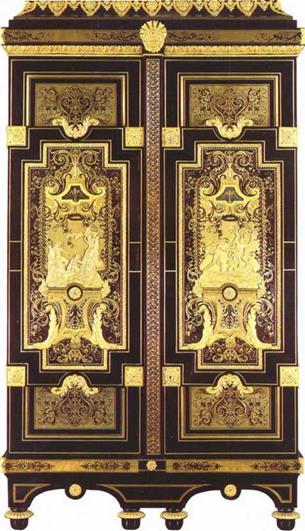Boulle’s workshop did not stamp its production. In the absence of a stamp the scholar must use archival sources to make attributions (such as the deed of gift
and the inventory after Boulle’s death, royal archives, the inventories of his clients, and the collection of his models engraved by Mariette after 1707. Nouveaux Desseins de meubles et ouvrages de marquelerie) and stylistic criteria. To a lesser extent the drawings in the Musee des Arts Decoratifs and the eighteenth-century sale catalogues are helpful, though the latter need to be consulted with care since they tend to attribute all furniture with tortoiseshell marquetry to him. From the royal records it is possible to attribute those commodes with mounts of winged female heads definitely to Boulle. It is recorded that he delivered a pair in 1708 for the King’s Bedchamber at Trianon [ 17J. Moreover. the deed of gift mentions three others in white wood in the workshop, proof that there were at least five constructed at that time. They can be followed through various sales during the eighteenth century: de Selle sale in 1761. lot 143: Randon de Boisset sale in 1777. lot 779: du Luc sale in 1770, lot 40; Marigny sale in 1781. lot 584; de Merle sale in 1784. lot 206;
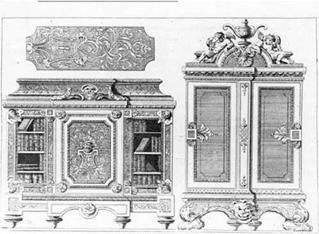
f 181 Additional plate to Mariettas folio of engraved designs by Boulle, 1707-30. The folio contained eight plates; however, the copy belonging to Baron Pichon, according to Guilmard, contained turn additional plates, of which this is one iBibliotheque Doucet, Paris)
/191 Imw bookcase, decorated with a figure of Bacchus. Similar examples, heightened during the reign of Louis-Philippe, are now in the Ijouvre and were confiscated at Chantilly during the Reivlutionfrom the Prince de Condf whose father was one of Boulle’s clients around 1720.
IPrivate collection)

![]()
Choiseul-Praslin sale in 1793, lot 244. An identical commode was confiscated from the Comte d’Artois* apartment at Versailles in 1794. The coffers in the J. Paul Getty Museum 114] can also be attributed with certainty: the identical description of one of them – though with different measurements – appears in the inventory of the collections of the Grand Dauphin with the words ‘made by Boullc’. It is possible that this was the coffer supplied in 1684 by Boulle to the Dauphin for 700 livres, according to the accounts of the Batiments (see below). A coffer of this type was part of the dealer Julliot’s stock and was included in his sale in 1777 as lot 706. A pair of comparable coffers are described in the Lauraguais sale in 1772. lot 20.
The series of low bookcases (19] with two glazed doors flanking a solid door decorated with mythologi – /20/ Oval commode with tortoiseshell and brass marquetry with amaranth borders. Two commodes of this type are termed ‘drum-shaped at each end’ and described in the deed of gift cf 1715. They were commissioned
cal figures must also be attributed to Boulle. The examples in the Louvre were confiscated from Chantilly during the Revolution and belonged to the Due de Bourbon who patronized Boulle in about 1720. This type was repeated for other private clients (de Merle sale in 1784. lot 208). The last royal commissions were the little tables supplied for the Menagerie in 1701, of a type that was seldom repeated. Four other pairs at the most are recorded (see below).
The deed of gift of 1715 facilitates further definite attributions: the armoire with long-case clock in the Wallace Collection 113] which appears first on the list, with pair in contrepartie, were estimated respectively at 5,000 livres and 4,000 livres. They were included in the Donjeux sale in 1793 as lots 546 and 547. It is also possible to identify a type of commode termed ‘en tambour par les deux bouts’ (drum-shaped on both sides) or ‘oval’ (20]. The Wallace Collection has two examples of this type. In the inventory of Boulle’s client, the financier La Croix, who owned four examples of this type of commode, they are described as being embellished with deep-rimmed tops in Chinese
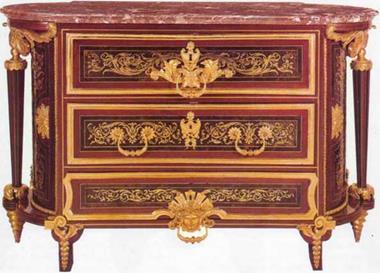
also retained until 1732 (no. 90). Apart from the example now in the Archives Nationales, formerly at Chantilly in the collection of the Due de Bourbon, several of these clocks appeared in eighteenth-century sales: Jullienne sale in 1767, lot 1632; Lauraguais sale in 1772, lot 23; Randon de Boisset sale in 1777, lot 799.
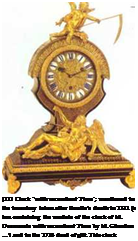 To this list can be added furniture mentioned in the inventory of 1732: the low armoires (22) with figures of the Seasons, also reproduced in the folio of Mariette engravings, a pair of which is now at Versailles, confiscated from the Duchesse de Noailles during the Revolution. Two of these armoires appear in the Jullienne sale in 1767, lot 1628, and according to the contemporary catalogue they were of a rare type.
To this list can be added furniture mentioned in the inventory of 1732: the low armoires (22) with figures of the Seasons, also reproduced in the folio of Mariette engravings, a pair of which is now at Versailles, confiscated from the Duchesse de Noailles during the Revolution. Two of these armoires appear in the Jullienne sale in 1767, lot 1628, and according to the contemporary catalogue they were of a rare type.
Mariette’s folio Nouveaux Desseins de meubles et ouv-
corresponds to a drawing in the Musee des Arts Dtcoratifs. There were several versions which can be recognized in the background of pointings by Jean-Franqois De Troy. ISotheby’s Monaco, 9 December 1984, lot 1030)
122) ‘Bas d’armoirc with Seasons’, one of a pair confiscated from the Duchesse de Noailles during the Revolution. Two identical pieces uvre in the Jullienne sale in 1767 where they are described as rare models. The
inivnlory drawn up after Boulle’s death in 1732 mentions ’a box containing models of the mounts made for the cupboards for M. de La Croix and Langlois amongst which are figures of the Four Seasons’. (MusSe de VersaillesI

lacquer. Two examples with marble tops appeared in the Lambert sale in 1787 as lots 301 and 302. There is also a clock embellished with figures of Venus and Cupid corresponding to examples now at Waddesdon Manor and in the Wallace Collection. The models of the figures remained in Boulle’s possession and are mentioned in the 1732 inventory (no. 79). The famous clock with the reclining figure of Time [21]. of which there exist numerous examples, may be identified as the one made for the financier Desmaretz. The various models of Time were the work of Girardon and are found in the 1732 inventory (no. 88). The ‘clock with the figures of the Fates’ may also be identified as one in the Wallace Collection. The models designed by Coustou are also mentioned in the 1732 inventory (no. 76). A second example of this clock with Fates appears in the same inventory; this must correspond to the clock with the Fates in bas-relief surmounted by a figure of Time of which one example was in the San Donato sale, while another is in the Louvre (former Fabre Collection). Another type of clock is mentioned in 1715: one with figures of Night and Day after Michelangelo, whose models Boulle
rages de bronze et marqueterie inventes et graves par Andrc-Charles Boulle (from which four plales are reproduced on the first and last pages of this book) facilitates the identification of other prototypes. The pedestals with aprons (plate I) were of a type often repeated. Numerous examples are to be found in eighteenth-century sales (two in the Randon de Bois – set sale in 1777 which reappeared in the Lebrun sale in
1778. lot 199; two in the Dubois sale in 1785. lot 216. and again in a Dubois sale in 1788. lot 153; two in the Choiseul-Praslin sale in 1793, lot 243. which came from the Julliot sale in 1777; and six examples in the Donjeux sale in 1793. lots 555-56 and 557). Many examples exist today (see under Appendix II below).
The sphinx clock illustrated in Mariette’s Plate II (see p.40) corresponds to another well-known type. An example in a private American collection was exhibited at the Frick Collection (‘French Clocks’) in 1982 and a second one supported on a stand was recently sold in Paris (Couturier-Nicolay sale. 7 December
1979. lot 124). The bureau plat with six legs in Mariette’s Plate III is comparable with a famous ex
ample formerly in the Ashburnham Collection |26) which also has convex drawer fronts. In the same print the right-hand section of the desk is reminiscent of the one at Vaux-le-Vicomte [251 which belonged to Randon de Boisset and was included in his sale in 1777, lot 781. In Plate IV. the two gueridons are also of a known model. An example of the one on the left, of a rare type, belonged to Anna Gould (sale Sotheby’s
|
|
|
|
||
|
|||
|
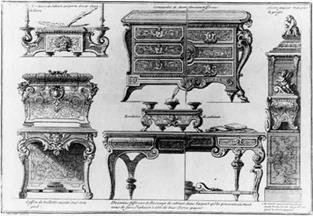


12bI Bureau plat corresponding to the left half of the bureau depicted in Plate III of the Boulle folio. IFormerly in the Earl of
Ashburnham’s collection, subsequently Patino Colin turn. Archives Galerie Аічгііпе, Paris)
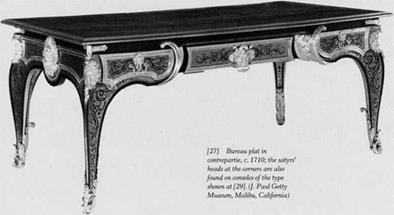
Monaco, 14 June 1982, lot 494). The second with ‘C’-scroll legs 123] is of a type often repeated in the Boulle workshop (Julienne sale in 1767. lot 1629).
The console with ram’s head in Plate V (see p. 440) is similar to the description of the one supplied by Boulle in 1701 to the Duchesse de Bourgogne at the Menagerie (mentioned above), as well as another one mentioned in Boulle’s 1732 inventory fa box containing the models for the Trianon commodes and "tables with rams’”). Boulle designed a series of these tables with variations: some were decorated with rams’ heads and hooves (Blondel de Gagny sale in 1776, lots 963-64, with three feet; Randon de Boisset sale in 1777, lot 784; Donjeux sale in 1793, lots 550-51 with two feet and faun’s head mask). Others arc decorated with lions’ heads and paws and three legs (du Luc sale in 1777, lot 44. with Apollo mask and fringes; Lc Boeuf sale in 1783, lot 213). The two tables now in the Wallace Collection and at Waddesdon Manor arc embellished with lions’ heads and resemble the du
Luc and Donjeux consoles, but with small discrepancies which render precise identification impossible.
On the same Plate V (see p. 440) is the base of a armoire with figures of the Seasons already mentioned, as well as a console with six legs of a well – known type, of which versions exist in the Wallace Collection and several private collections (see under Appendix II below; (29]). Such consoles frequently appear in eighteenth-century sales (Julienne sale in 1767, three examples, nos 1642, 1648 and 1649; Dubois sale in 1785, lot 215 in contrepartie; Chevalier Lambert sale in 1787, lot 310).
The drawings of furniture attributed to Boulle in the Musee des Arts Decorat ifs are problematic. It would apparently seem unwise to rely on them for the purposes of attribution; yet the majority of-these drawings in black or red chalk would seem to be by the same hand; moreover, they correspond to works definitely by Boulle and it is known that he made draw-
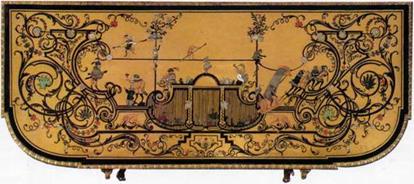
/ 28] Top of a console on six legs with motif of an aviary drawn by monkeys. (Archives Calerie Gismondi, Paris)
/29/ Console supported on six legs, of a model depicted in Plate V of Boulle’s folio of engravings as well as in a drawing of the Musee des Arts D&xnatifs. The
mounts (satyrs’ heads on the legs and fauns’ masksI are also found on various bureaux plats. (Sotheby’s Monaco, 14 June 1982, lot 4921
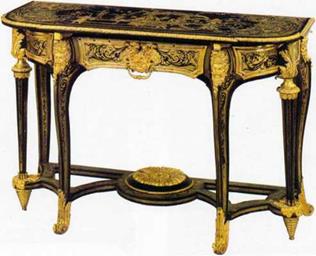
йоги. к
ings himself (as indicated by the title of the engraved folio). ()ne of the drawings of an armoire (30] bears an inscription on the reverse concerning a delivery of sconces made by Boulle for the I )auphin at Meudon in
1701. From this drawing it is possible to attribute the two large armoires now in the Louvre to him (31] as well as the group of bas d’armoires with figures named ‘Religion and Wisdom’. These figures are actually Aspasia and the Philosopher and were inspired, as Beatrix Saule has discovered, by motifs painted by Corneille in the Queen’s Antechamber at Versailles. This group can therefore Ik* dated after 1701. probably from 1710-25. They appear in various sales during the eighteenth century: a pair. Gaillard de Clagny sale in 17(>2. lot 54. described as being ‘by Boulle the
Elder’; a single one. Blondel de Clagny sale in 1770. lot 055: a pair in the Poulain sale in 1780. lot 188. two pairs, first in thcSainte-Foix sale in 1782. lots 142 and 143. then in the Lelxjeuf sale of 1783, lots 200. 210. described with 6 medals on each door; a pair in contre – partie in the Choiseul-Praslin sale in 170.3. lot 242; a pair in premiere partie in the Grimod de la Reyniere sale in 1707. lot 107 and another pair in contrepartie in the same sale, lot 108; finally, three pairs in contrepartie in the Choiseul-Praslin side of 1808. lots 55-57. which were purchased by Demidoff. Many pieces from this group are today at Versailles, confiscated during the Revolution from Lenoir du Breuil or the Due de Noaillcs and stamped by the ebenistes who were required to restore them for resale during the
|
|
||
|
|||
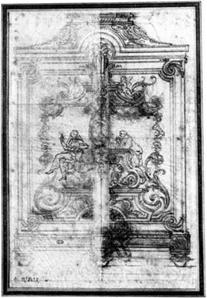
/321 Low аттоіте, c. J 725, one of a pair with figures of Aspasia and the Philosopher; the various recorded examples leight pairs at least)display small differences, for example, in the ribbons tied to medals and the number of
medals. It is therefore possible to identify this pair in the Sainte – Foix sale in 1782, then in the Le Boeuf sale in і 783, together with a second pair in соп<ггрдг<і>.
(Private collection)
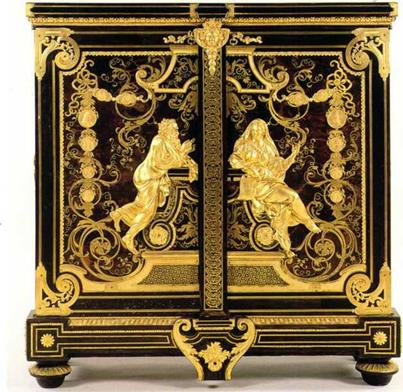
second half of the eighteenth century: J. – F. Delorme and Montigny. Two others, of inferior quality, from the Roudinesco Bequest, are definitely pastiches made in the 1770s by Montigny for the dealer Julliot. Another drawing in the Musee des Arts D&oratifs can be linked to a famous armoire now in the Louvre [53] whose pair is now in the Hermitage; it corresponds to the description of an armoire in the Wat – tevillesale in 1779. lot 117, which later belonged to M. de Goguelat.
Besides this group of furniture, whose attribution to Boulle is certain, it is possible to attribute to him numerous other pieces decorated with the same marquetry and bronze mounts:
– The large armoires of the type represented by the one in the Wallace Collection [59] decorated with the story of Apollo, his pursuit of Daphne and the flaying of Marsyas. Many of them are decorated with fleurs – de-lys on the hinges, suggesting a provenance within the royal family; one of them appeared in the Julliot sale in 1777.
– A group of low bookcases with glazed doors decorated with putti [60] are based on the bookcases from Chantilly, and can be linked to an entry in the 1732 inventory (‘no. 46 – a box containing the chased and repaired models with decorative elements and putti from the cabinet of M. Bourvalais’). The pair at Versailles were confiscated during the Revolution from the Due de Brissac. A second pair (private collection) were in the Blondel d’Azincourt sale in 1782, lot 414, where they were attributed to Boulle.
– The bureaux plats are of two different types. The first type, with concave apron and central everted drawer, is represented by various examples of which the finest is at Boughton House, Northamptonshire. This type with sabre legs typical of Boulle would seem earlier than the second, with cabriole legs and recessed central drawer, the design of which corresponds to that of Regence bureaux. It is not possible to make accurate identifications from the vague descriptions in eighteenth-century catalogues. Moreover, their appearance in portraits by Roslin in the 1770s and 1780s occurs too regularly to imply that they belonged to the subject of the painting in each case. It was obviously a status symbol for financiers and important people of the time.
– 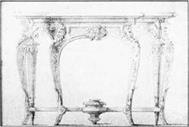
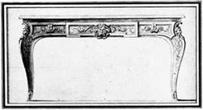
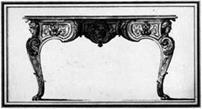
![]() The most common type of cabinet was usually one with a high marquetry base, as can be seen in the
The most common type of cabinet was usually one with a high marquetry base, as can be seen in the
drawing in the Musee des Arts Decoratifs and the two examples in the Louvre. In the inventories or sales of Boulle’s clients such as Pierre Thome in 1710 or Jean dejullienne in 1767. lot 1653. these cabinets still have their marquetry bases supported on square tapering feet. They are also found described in the sales of Gaillard de Gagny in 1762. lot 55. Randon de Boisset in 1777 and then Lebrun in 1778. However, in the deed of gift of 1715. the bases are described separately from the cabinets (‘twelve cabinet bases with square
|
|
tapering feet, the cabinets being in deal ), indicating that the cabinets could lx; sold separately. In this case they were probably placet! on giltwood bases. An example was in the IXic de Tallard sale in 1756. lot 1033. In the sale catalogues of the last third of the eighteenth century, many of these cabinets appeared without their stands and it is in this state that the majority of them have survived to the present day: Julliot sale in 1777, lots 694—95: Dubois sale in 1788. lots 148-49; Mme Lenglier sale in 1788. lot 344; Tricot d’Espagnac sale in 1793. lot 208; Donjeux sale in 1793: Lambert sale in 1787. a pair, lot 306 and a third, lot 308: Marigny sale in 1782. lot 586. It is highly likely that they were transformed into low cabinets in the 1770s by removing the table-like stands and replacing them with plinths and short spiral feet, the wooden tops being replaced with marble (38J. The elxniste responsible for these changes was definitely Levasseur who stamped many examples of this type, probably on commission from the dealer Julliot: it cannot lx* coincidental that this type of low cabinet first appeared among the sale of Julliot’s stock and afterwards appeared in other dealers’ sales (Dubois, Mme Lenglier. Donjeux).
|
|
 |
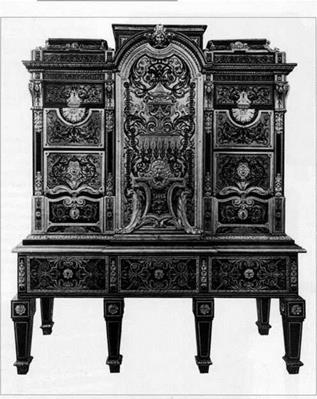 |
– There is also another, rarer type of cabinet designed with a central dome, which can also be attributed to Boulle. These cabinets, of larger dimensions than the first type, were also supported on high bases. The one in the Tallard sale of 1756, lot 1032. had a giltwood base. The example in the Jullienne sale in 1767. lot 1645, was described as having a base with six legs of square section, veneered in ebony with three drawers in marquetry’, and this can be linked to a similar example in the Sheremetiev Collection now in the Hermitage [39]. Two other similar cabinets in contrepartie appear in the Grimod de la Reyniere sale
in 1797, lot 106, on a ‘base serving as supports with three drawers’, perhaps of the same type.
– Caskets, also called coffres de toilette’ in Mariette’s folio of engravings, could also serve as medal cabinets or jewel-cabinets. As in the case of the cabinets they were supported on bases, generally with square tapering feet in marquetry [41]. These are thus mentioned in the probate inventories of Boulle’s clients. Among the effects of Pierre Gruyn in 1722 was found ‘a small marquetry coffer, work by Boulle enriched with gilt-bronze mounts, on its base. 800 livres’. and among the effects of Etienne Moulle in
![]()
![]()
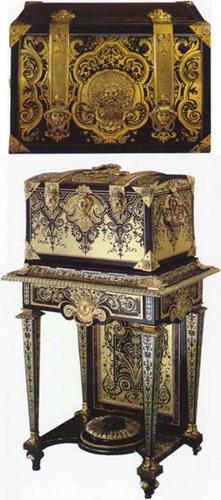 1702 ‘two caskets with their Boulle marquetry stands embellished with gilt-bronze mounts. 500 livres’. They are to be found in many sales during the eighteenth century with this type of stand: one in the Angran de Fonspertuis sale of 1748. lot 370; a pair. Jullienne sale in 1767. lot 1635. described as having ‘a base with five legs’; a pair. Lauraguais sale in 1772, lot 21; a single example. Lambert sale in 1787. lot 309; a pair. Dubois sale in 1788, lot 250; one only. Segur-de Clesle sale in 1793. lot 219. Another type of base composed of cabriole legs with female heads is also mentioned in old sales (Gaillard de Gagny sale in 1762. lot 56; and a pair in contrepartie. Dubois sale in 1785. lot 219). They correspond to the coffers now at Blenheim Palace and Schloss Moritzburg, near Dresden.
1702 ‘two caskets with their Boulle marquetry stands embellished with gilt-bronze mounts. 500 livres’. They are to be found in many sales during the eighteenth century with this type of stand: one in the Angran de Fonspertuis sale of 1748. lot 370; a pair. Jullienne sale in 1767. lot 1635. described as having ‘a base with five legs’; a pair. Lauraguais sale in 1772, lot 21; a single example. Lambert sale in 1787. lot 309; a pair. Dubois sale in 1788, lot 250; one only. Segur-de Clesle sale in 1793. lot 219. Another type of base composed of cabriole legs with female heads is also mentioned in old sales (Gaillard de Gagny sale in 1762. lot 56; and a pair in contrepartie. Dubois sale in 1785. lot 219). They correspond to the coffers now at Blenheim Palace and Schloss Moritzburg, near Dresden.
The various types of commodes made by Boulle are of an astonishing inventiveness. Besides the two types already mentioned as identifiable from the records, it is possible to attribute several others to him:
– The type of commode in arched form decorated with faun’s head (42) may be followed in several sales of the eighteenth century (Marigny sale in 1781. lot 583; Le Boeuf sale in 1783, lots 206 and 207; Vau – dreuil sale in 1787. lots 359 and 369; Donjeux sale in 1799. lot 553).
– Another type decorated with lions’ heads of which two examples were in the Wildenstein Collection (44) must also be attributed to Bodies workshop. This type is found in various important sales (Vaudreuil sale in 1787. lot 394; Donjeux sale in 1793. lot 552; Jul – liot sale in 1777. lots 698 and 699).
– A rare type of commode with caduceus (65). in fact conceals a medal-cabinet. The only two examples recorded (J. Paul Getty Museum and Hermitage) were originally a pair which belonged to the daughter of the goldsmith Delaunay who was also the daughter-in-law of Robert de Cotte.
There are several types of pedestal attributed to Boulle in contemporary sale catalogues:
– The most sumptuous, the octagonal pedestal with a door, is described with its pair in the sale of Dubois’ assets in 1788, lots 168 and 169. Another one in contrepartie was in the de Merle sale in 1784, lot 211.
– Pedestals with bowed fronts of the type at Chats – worth and in the Saint-Senoch Collection (62) are mentioned in the du Luc sale in 1777. lot 43 and the Le Boeuf sale in 1783. lot 211.
– Square tapering pedestals of rectangular section of
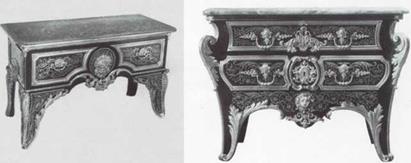
(42J Comnwdc, с. 1700-10. Called ‘tables en bureaux’ at the time, these early commodes in fact derive from a type of bureau in the form of an arch. (Muste du Louvre, ParisI
1431 Commode, c. 1720, a variant of the Wildenstein commode; the corners are derived from certain bureau forms of Boulle. (WallaceCollection, London)
/44] (below) Commode, с. 1720. The final form of the commode is here achieved. The Bacchus mask is typical of Boulle. It is stamped Levasscur who restored it in about
1770-80. It appeared with its pair in the Jullienne sale in 1777, then alone in the Calonne sale in 1788. (Formerly in the Wildenstein Collection; Sotheby’s Monaco, 25 June 1979)
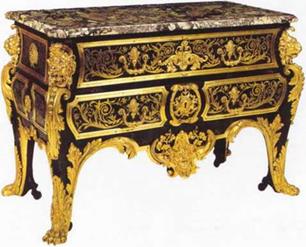
![]()
![]()
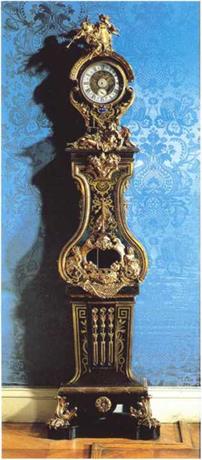
the type in the Victoria and Albert Museum are rarer. The three pairs in the Lambert sale in 1787 fetched high prices, nearly 1.3(H) livres each. There were also comparable examples in the de Billy sale in 1784. lot 174 and the Dubois sale in 1785. lot 214.
There is a reference in the deed of gift of 1715 to the model of a small medal cabinet (eight small medal cabinets commenced for M. de Launay of which half are in amaranth and the remainder with marquetry, valued at 480 livres’). It is tempting to identify them with those containing the sixty-five medals of the Kings of France of which Marigny owned an example in amaranth (Sotheby’s Monaco. 4 December 1983, lot 314) and the Due de Bourbon’s two examples with marquetry, today in the Bibliotheque Nationale.
Clocks represented alx>ut a third of the output of Boulle’s workshop. The deed of gift itemizes 63 out of a total of 3(H) pieces and the inventory taken after the fire lists 75 out of a total of 220. (By comparison, there were 32 commodes in 1715 and 18 in 1720.) Among the principal clock-makers in Paris who commissioned cases from Boulle. mention must be made of Isaac Thuret (died 1706) and his son Jacques (died 1738). who also had workshops at the Louvre; Balthazar Martinot (1636-1716). ‘horloger ordinaire du roi’, from whom the Grand Dauphin ordered several clocks; his cousin Louis-Henry Martinot (1646-1725). ‘valet de chambre horloger du roi’. also with a workshop at the Louvre and Girardon’s son-in – law; Antoine Gaudron (retired in 1711), who amalgamated with his son Pierre in 1698 (retired in 1728. died in 1745); Nicolas Griljelin (1637-1719). ‘horloger to Monseigneur’ in 1674; Louis Mynuel (died 1742). ‘marchand-horloger privilegie du roi’ in 1705; Francois Rabby (about 1655-1717). ‘horloger de la Duchesse d’Orleans’ in 1686. Their names occur regularly in the inventories of Boulle’s clients. Several well – known long-case clocks with tortoiseshell marquetry can be attributed to Boulle: the one in the Louvre (45) was made for the Paris residence of the Comte de Toulouse, now the Bank of France, in about 1720. after a drawing by Antoine Vasse now in the Musee des Arts Decoratifs. Another long-case clock has similar
1461 Armoire in contrepprtie decorated with scenes from the myth of Apollo – Apollo and Marsyas; Daphne and Apollo.
IPrivate collectionI
|
|
decoration to the central part of an armoire in the Wallace Collection (58]. The Saturn mask corresponds to one mentioned in the 1732 inventory (‘no. 47 – a cast of the large head of Saturn with its decoration for the long-case clock of M. le Prince de Conde’). This probably refers to the one bought by the Prince de Conde from Boulle and the clock-maker Rabby in 1707-08 for the Yellow Salon in his Paris house. The dimensions cited in the inventory of 1723 of the Petit Luxembourg correspond (‘97« pieds in height’). The works were originally by Rabby but were replaced during the reign of Louis XVI.
A clock with the figure of Atlas can be recognized in the inventory of the wife of one of Boulle’s clients. Mme Le Bas de Montargis. done in 1748 at her house in the Place Vendome. The example in the Conservatoire des Arts et M£tiers, dated 1712. is signed by Thuret, precisely as was the one belonging to Mme de Montargis. There is a drawing by Gilles-Marie Oppe – nord in the Musee des Arts Decoratifs for the stand which supports it. Boulle repeated this model on two occasions (former Rothschild Collection, Chateau de Ferriere; sale Sotheby’s Monaco. 15 June 1981. lot 142). The clock with the chariot of Apollo, of which two examples exist (Chateau de Fontainebleau and the Residenz. Munich (81] on a later pedestal), corresponds to an example attributed to Boulle in the Blondel de Gagny sale in 1776. lot 1022 and which was in the sale of his son Blondel d’Azincourt in 1783 with the annotation ‘made for the Regent’. The Fontainebleau example was confiscated from the Prince de Cond£ at Chantilly during the Revolution. Finally there are several drawings of long-case clocks in the Ми8ёе des Arts IXicoratifs corresponding to models by Boulle with cockerels’ heads and other figures from Boulle’s repertoire.

